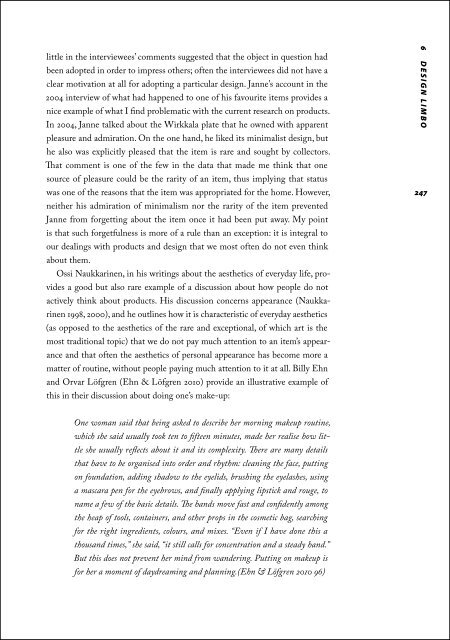Lataa ilmaiseksi
Lataa ilmaiseksi
Lataa ilmaiseksi
Create successful ePaper yourself
Turn your PDF publications into a flip-book with our unique Google optimized e-Paper software.
little in the interviewees’ comments suggested that the object in question had<br />
been adopted in order to impress others; often the interviewees did not have a<br />
clear motivation at all for adopting a particular design. Janne’s account in the<br />
2004 interview of what had happened to one of his favourite items provides a<br />
nice example of what I find problematic with the current research on products.<br />
In 2004, Janne talked about the Wirkkala plate that he owned with apparent<br />
pleasure and admiration. On the one hand, he liked its minimalist design, but<br />
he also was explicitly pleased that the item is rare and sought by collectors.<br />
That comment is one of the few in the data that made me think that one<br />
source of pleasure could be the rarity of an item, thus implying that status<br />
was one of the reasons that the item was appropriated for the home. However,<br />
neither his admiration of minimalism nor the rarity of the item prevented<br />
Janne from forgetting about the item once it had been put away. My point<br />
is that such forgetfulness is more of a rule than an exception: it is integral to<br />
our dealings with products and design that we most often do not even think<br />
about them.<br />
Ossi Naukkarinen, in his writings about the aesthetics of everyday life, provides<br />
a good but also rare example of a discussion about how people do not<br />
actively think about products. His discussion concerns appearance (Naukkarinen<br />
1998, 2000), and he outlines how it is characteristic of everyday aesthetics<br />
(as opposed to the aesthetics of the rare and exceptional, of which art is the<br />
most traditional topic) that we do not pay much attention to an item’s appearance<br />
and that often the aesthetics of personal appearance has become more a<br />
matter of routine, without people paying much attention to it at all. Billy Ehn<br />
and Orvar Löfgren (Ehn & Löfgren 2010) provide an illustrative example of<br />
this in their discussion about doing one’s make-up:<br />
6 D E S I G N L I M B O<br />
247<br />
One woman said that being asked to describe her morning makeup routine,<br />
which she said usually took ten to fifteen minutes, made her realise how little<br />
she usually reflects about it and its complexity. There are many details<br />
that have to be organised into order and rhythm: cleaning the face, putting<br />
on foundation, adding shadow to the eyelids, brushing the eyelashes, using<br />
a mascara pen for the eyebrows, and finally applying lipstick and rouge, to<br />
name a few of the basic details. The hands move fast and confidently among<br />
the heap of tools, containers, and other props in the cosmetic bag, searching<br />
for the right ingredients, colours, and mixes. “Even if I have done this a<br />
thousand times,” she said, “it still calls for concentration and a steady hand.”<br />
But this does not prevent her mind from wandering. Putting on makeup is<br />
for her a moment of daydreaming and planning.(Ehn & Löfgren 2010 96)
















